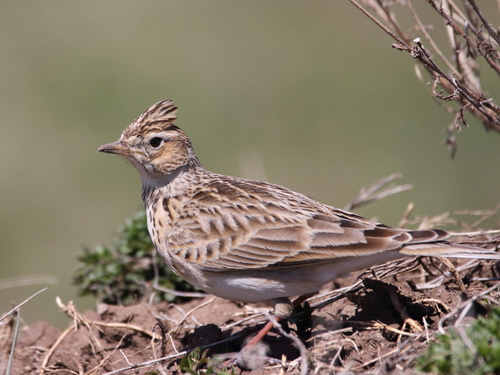
Eurasian Skylark
The Eurasian Skylark (*Alauda arvensis*) is a small passerine bird renowned for its elaborate song flight, a continuous stream of melodious notes delivered high in the air. This seemingly tireless performance has made the skylark a symbol of joy and inspiration in literature and folklore across Europe and Asia. Ecologically, skylarks play a role in seed dispersal and insect control within grassland and agricultural ecosystems. They are ground-nesting birds, making them particularly vulnerable to changes in land use and agricultural practices.
16-18 cm
Length
30-36 cm
Wingspan
Least Concern
Conservation Status
Distribution
The Eurasian Skylark has a vast range, breeding across Europe and Asia, and extending into North Africa. It has also been introduced to other parts of the world, including North America, Australia, and New Zealand. Some populations are migratory, moving south for the winter, while others are resident year-round. They occupy a wide altitudinal range, from sea level to mountainous regions.
Lifespan
The average lifespan in the wild is around 3-4 years, although some individuals can live longer.
Eurasian Skylark's Habitat
Habitat Types
Grasslands, Farmland, Heathland, Moorland, Coastal dunes
Climate Zones
Temperate, Boreal, Mediterranean
Adaptations
Their streaked brown plumage provides excellent camouflage on the ground, blending in with the soil and vegetation. Strong legs are adapted for running and walking across open terrain.
Variations
Several subspecies are recognized, differing slightly in plumage and size. These variations are often linked to geographic location and habitat type.
Appearance
Breeding Plumage
There is little difference between breeding and non-breeding plumage. Both are generally streaked brown above and pale below, with a small erectile crest.
Seasonal Feather Changes
Plumage may appear slightly fresher and more contrasting after molting.
Sex Based Plumage Differences
Males and females have very similar plumage.
Notable Features
Small erectile crest, Streaked brown upperparts, White outer tail feathers (visible in flight), Long hind claws
Diet and Feeding
Primary Foods
Seeds, Insects, Spiders, Other invertebrates
Foraging Behavior
Skylarks forage on the ground, walking and running to pick up seeds and insects. They often probe the soil with their bills to find prey.
Specializations
Their relatively long, straight bill is well-suited for picking up small items from the ground.
Seasonal Diet Variations
The diet varies seasonally, with a greater proportion of insects taken during the breeding season to feed young, and more seeds consumed during the winter.
Behavior
Social Structure
Skylarks are generally solitary or found in pairs during the breeding season. Outside of the breeding season, they may form small flocks.
Communication
Complex and melodious song (delivered during flight), Short, sharp calls (used for alarm or contact)
Migration
Many populations are migratory, undertaking long-distance journeys between breeding and wintering grounds. The timing and extent of migration vary depending on the population.
Territorial or Group Behaviors
Males are territorial during the breeding season, defending their nesting area through song and aerial chases.
Conservation
Threats
Habitat loss (due to agricultural intensification), Pesticide use, Changes in farming practices (e.g., earlier harvesting), Predation (by ground predators and birds of prey)
Protection Programs
Agri-environment schemes (designed to promote skylark-friendly farming), Habitat restoration projects
Local National Laws
Protected under various national and international wildlife legislation.
Population Trend
Decreasing in many parts of its range, particularly in Western Europe.
Population Estimates
The global population is estimated to be in the tens of millions, but accurate figures are difficult to obtain.
Interesting Facts
The skylark's song can last for several minutes without a break.
This remarkable feat is achieved through a specialized syrinx (vocal organ) and efficient breathing techniques.
Skylarks can sing at altitudes of up to 300 meters (almost 1000 feet).
This high-altitude singing helps to broadcast the male's song over a wide area.
Skylarks have inspired numerous poems and pieces of music.
Famous examples include Percy Bysshe Shelley's "To a Skylark" and Ralph Vaughan Williams' "The Lark Ascending".
Faqs about Eurasian Skylark
Why are skylark populations declining?
The main reason is the intensification of agriculture, which has led to habitat loss, reduced food availability, and increased nest destruction.
What can I do to help skylarks?
Support conservation organizations working to protect skylarks and their habitats. If you live in a rural area, consider adopting skylark-friendly practices on your land.
Where is the best place to see a skylark?
Open grasslands, farmland, and heathland are good places to look for skylarks, particularly during the breeding season when males are singing.
Copyright @ Nature Style Limited. All Rights Reserved.
 English
English